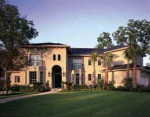Search engine visitors - click here to access entire "$ensible Home" web site
Click here to see a descriptive illustration several new concrete construction methods and a concrete house
Dear Jim: We are planning to build an efficient new house. We are considering one made primarily of concrete for its strength against tornadoes and fire. Does this make sense and what are our options? - Sam W.

A: Building a concrete-framed house makes a lot of sense for many reasons. The final structure is extremely strong and can withstand tornadoes and hurricanes. Using concrete construction also gives your architect more flexibility, creating a unique house design in both the exterior and interior.
Building a concrete house is environmentally friendly since cement and gravel, the basic components of concrete, are abundant. The thermal mass of the concrete is ideal for passive solar heating and improves air-conditioning comfort during the summer. You may also find lower fire insurance rates.
When people think of a "concrete" house, they often think of concrete blocks. There are actually many excellent house construction methods that use concrete as the base material. Once these houses are completed, they look identical to any other conventionally built houses.
Standard concrete itself is not a good insulator, so most concrete building systems use either foam insulation panels or insert granulated foam into the concrete mixture. Even if the insulation value is not the highest, these houses settle very little, so they stay airtight and efficient.
One construction method, shotcrete, uses concrete sprayed over a thick foam insulation core. It usually consists of cement and sand, but sometimes small pea gravel is added. Completed concrete walls are strong and airtight. The insulation value of them depends on the thickness of the foam core.
Another efficient method, aerated concrete, produces strong, lightweight concrete construction panels. Some of these panels can be cut with standard woodworking tools. They are made using fine cement and steam to create tiny, insulating bubbles inside the finished concrete panel or blocks.
Using stay-in-place concrete foams is another super-efficient construction method. The concrete forms, which are generally wood, are made of rigid foam insulation instead. Flat sheets separated by fasteners or blocks that are stacked can be used. When the concrete sets, the foam stays in place.
A final option is using preinsulated concrete blocks. The blocks may have narrower internal webs or have foam beads mixed into the concrete. Foam inserts can be placed inside the block cavities.
Any standard exterior wall treatment - brick, siding, stone, stucco, etc. can be used to finish the exterior of a concrete house. Stucco is particularly well suited to this type of construction and it is attractive. It requires little maintenance, applies quickly and seals small gaps and air leaks.
Instant Download Update Bulletin No. 860 - list of 21 concrete system manufacturers, descriptions of the various building methods (insulating concrete forms, concrete block systems, panel systems, aerated concrete systems, shotcrete systems, removable forms and stucco basics, illustrations throughout, floor plan with exterior diagram.
Dear Jim: I have cold water pipes that run through our basement and into a first floor utility room. I put foam insulation over the pipes, but they still sweat and drip. What can I do so stop the dripping? - Ann R.
A: You must either reduce the humidity level in the basement and utility room or somehow block the room air from reaching the cold pipes. Leaving interior doors opened to those rooms may help lower the humidity.
Your idea of insulation is fine, but it must seal against the pipe to block the air contact. Gluing the insulation to the pipe can help. You can also try using some spray-on insulation to coat the pipes.